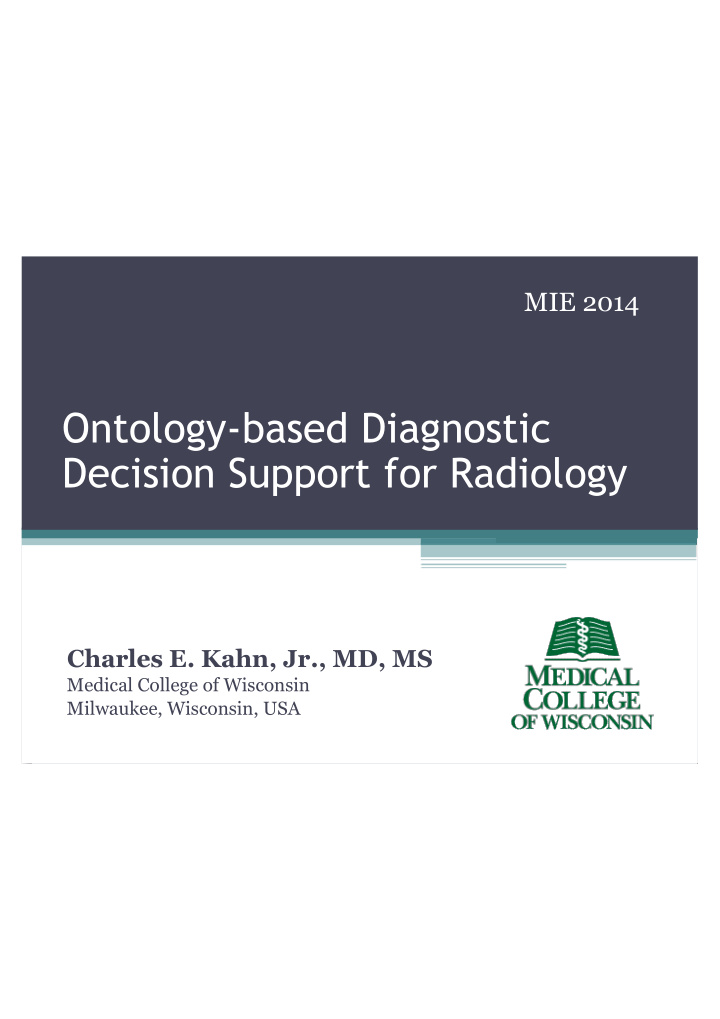



MIE 2014 Ontology-based Diagnostic Decision Support for Radiology Charles E. Kahn, Jr., MD, MS Medical College of Wisconsin Milwaukee, Wisconsin, USA
Goals • Apply an ontology of disorders and associated imaging findings for differential diagnosis • Develop user interface and web service API for knowledge query • Demonstrate valid application of the ontology’s knowledge
Radiology Gamuts Ontology (RGO) • Large and growing knowledge model ▫ Diseases ▫ Imaging observations • Constructed from several differential diagnosis references • Serves as a form of "computable knowledge" to aid in radiological diagnosis
Ontology Structure • Entity ▫ disorder chronic hepatitis ▫ intervention steroid therapy ▫ observation misty mesentery • Relation ▫ subsumption (“is a”) ▫ causality (“may cause”)
Radiology Gamuts Ontology • Standardized knowledge representation ▫ Normalized entity names + synonyms ▫ Ability to reason over domain • Interoperability / knowledge integration ▫ Mappings to other ontologies ▫ Knowledge-based applications
Gamuts Ontology • Content ▫ 16,822 terms ▫ 1,755 subsumption relations ▫ 53,638 causal relations • User interface ▫ Web site ( www.gamuts.net ) ▫ RESTful web service / JSON
Imaging findings and diseases Causal relationships gamuts.net
Differential Diagnosis (“DDx”) • Identify the cause(s) of a set of findings ▫ Each diagnosis explains all imaging findings that have been asserted • “Discriminators” ▫ Union of findings of each listed diagnosis • exclude asserted findings • exclude findings common to all listed diagnoses ▫ Additional findings that can reduce the DDx list
DDx Example • Finding ▫ hypertelorism • Diagnosis ▫ 151 diagnoses ▫ “Aarskog syndrome” to “XXXY syndrome” • Discriminators ▫ 976 discriminators ▫ including acro-osteolysis, abnormal sternum, clubfoot, tracheomalacia, Wormian bones
DDx Example: 2nd finding • Findings ▫ hypertelorism ▫ abnormal sternum • Diagnosis (disorders that cause both findings) ▫ Brachmann-de Lange syndrome ▫ Rubinstein-Taybi syndrome ▫ cleidocranial dysostosis ▫ Seckel syndrome ▫ Noonan syndrome ▫ XXXXY syndrome • Discriminators
DDx Example: 3rd finding • Findings ▫ hypertelorism ▫ abnormal sternum ▫ Wormian bones • Diagnosis (disorders that cause all 3 findings) ▫ cleidocranial dysostosis • Discriminators ▫ (none)
Gamuts DDx • User interfaces ▫ Web site ( gamuts.net/ddx ) ▫ Web service (see gamuts.net/dev )
gamuts.net/ddx
gamuts.net/ddx
"finding": [ "hypertelorism", "Wormian bones" ], "diagnosis": [ "aminopterin fetopathy", "cleidocranial dysostosis", "metaphyseal chondrodysplasia Jansen type", "normal variant", "Ritscher-Shinzel syndrome", "Schinzel-Giedion syndrome", "sclerosteosis" ], "discriminator": [ { "name": "abnormal fibula", "n": "1" }, { "name": "widespread predominantly medullary osteosclerosis", "n": "1" }
Mappings • RadLex • SNOMED CT • OrphaNet Rare Disease Ontology (ORDO) • Bone Dysplasia Ontology (BDO)
Conclusions • Working system for differential diagnosis • Valid application of diagnostic knowledge • Requires diagnoses to cause all asserted findings
Future Work • Test on clinical cases • Apply “transitive closure” over ontology • Integrate with NLP tools • Incorporate probabilistic knowledge + reasoning
Thank you !
Recommend
More recommend